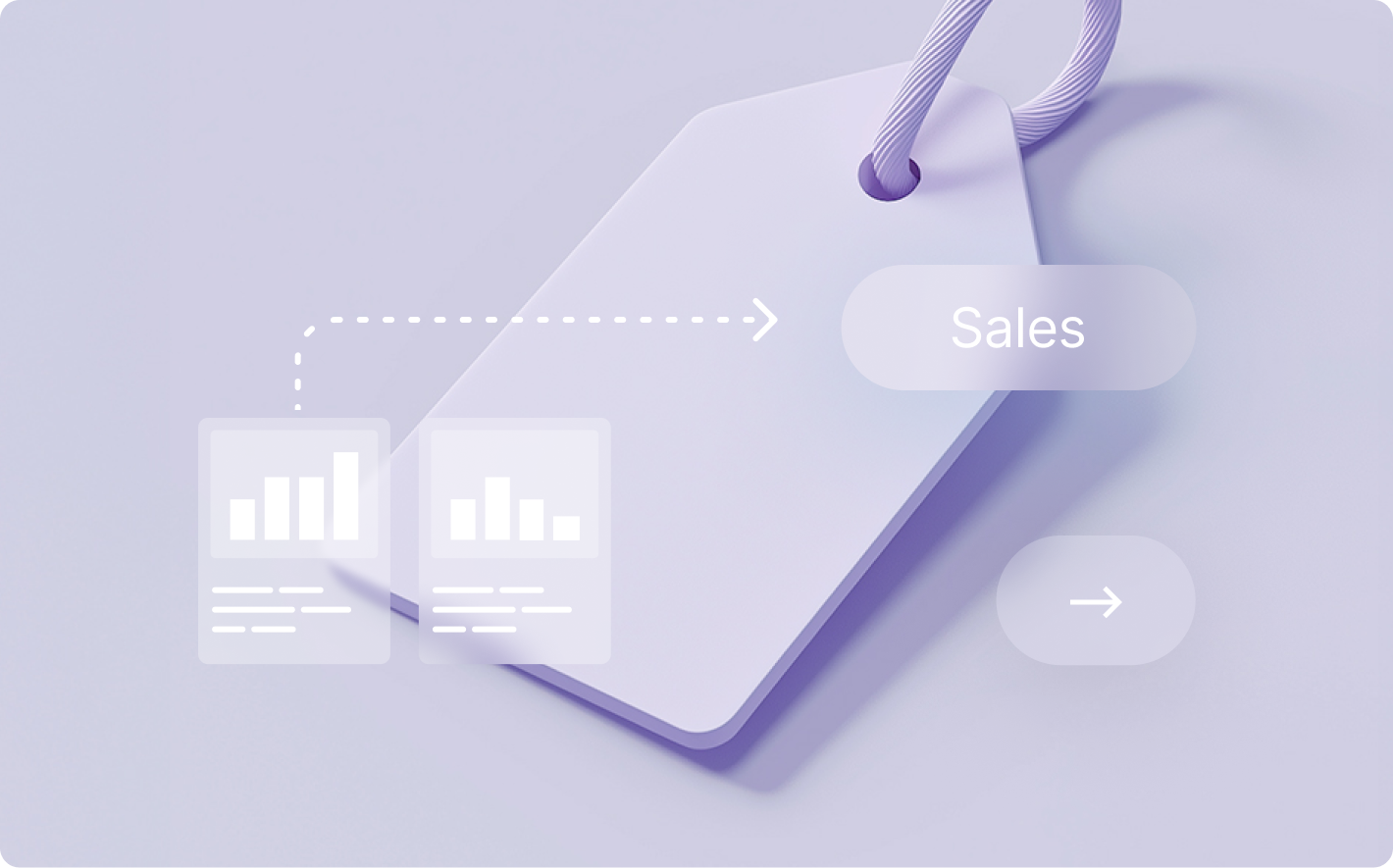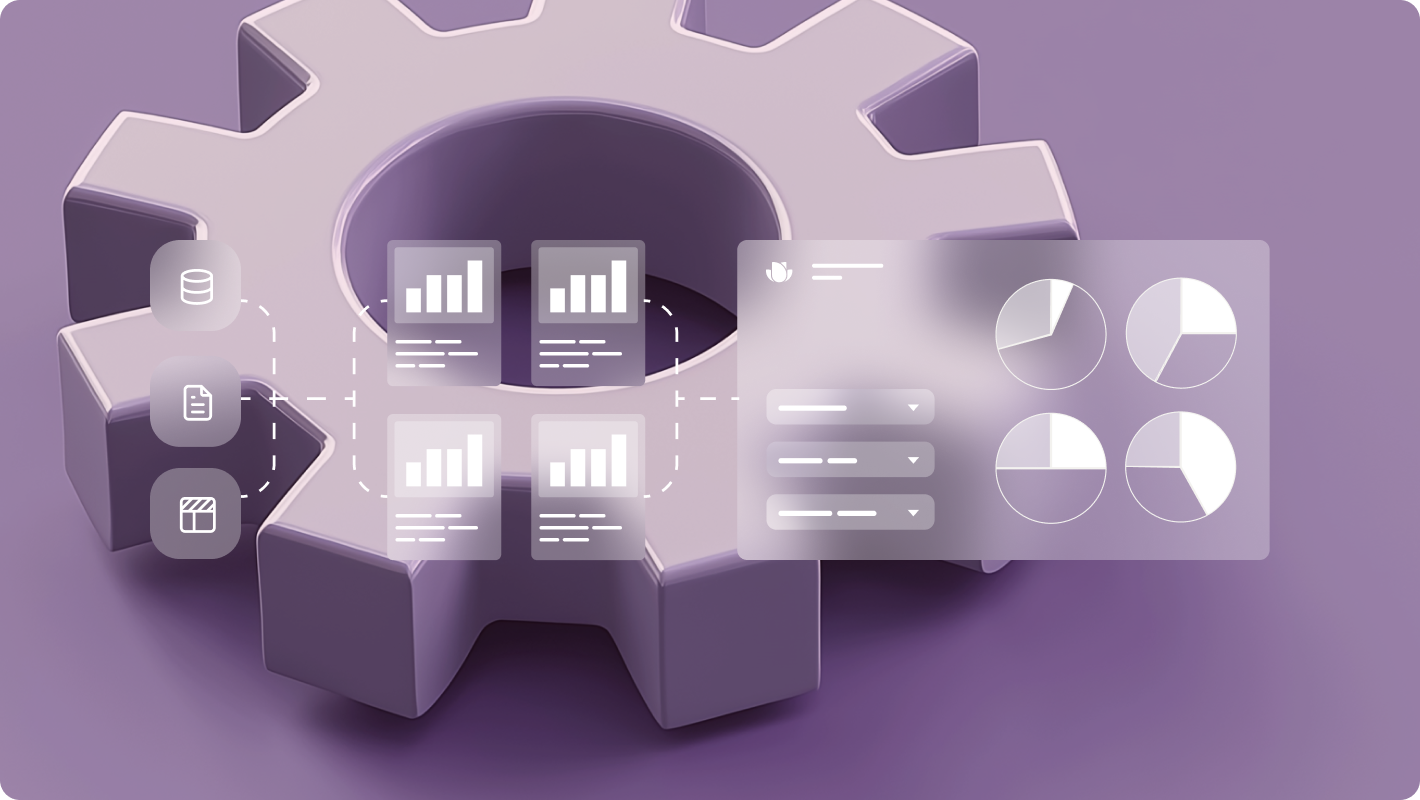Part 3: The Ultimate Guide to B2B SaaS KPIs: Mastering Sales Metrics

Co-founder & CTO
Ready to build a sales motion that closes deals like clockwork?
In the previous two parts, we covered the financial fundamentals and the marketing magic that fuels SaaS growth. Now, it's time to focus on the final piece of the puzzle: Sales Performance.
These KPIs are your dashboard to sales mastery, giving you a granular view of your team's effectiveness, their pipeline health, and how efficiently they're turning leads into paying customers (and ideally, raving fans).
We’ll dissect essential metrics like average deal size, sales cycle length, and quota attainment, showing you how to optimize every stage of your sales process for maximum impact.

1. Sales KPIs: Driving Revenue and Measuring Performance
Plus, we'll explore the best practices for tracking your KPIs like a pro, using the right tools to streamline your analysis and reporting. Get ready to unleash your sales team's full potential and watch your numbers explode.
Sales KPIs provide a granular view of your sales team's performance, pipeline health, and how effectively they're turning leads into paying customers.
Think of these metrics as your sales team's report card—they highlight what's working, what needs a little extra attention, and how well your team is converting leads into revenue.
Use these insights to identify areas for improvement, optimize your sales process, and ultimately, drive more revenue growth. They're the key to fine-tuning your sales machine and maximizing your revenue potential.
1.1 Number of Sales Qualified Leads (SQLs): Filling the Pipeline
This measures the volume of high-potential leads passed from marketing to sales. It’s a key indicator of how effective your marketing is at generating leads that are ready for a direct sales approach. It’s about keeping the pipeline flowing.
Why SQLs Matter:
- Sales Pipeline Health: A healthy flow of SQLs is essential for a strong sales pipeline. Enough SQLs ensures a steady stream of potential deals for your sales team to work on. It’s about keeping them busy with the right opportunities.
- Revenue Potential: SQLs represent a significant revenue opportunity. These qualified leads are more likely to convert into paying customers, directly contributing to your bottom line. It’s about maximizing revenue potential.
- Marketing & Sales Alignment: Tracking SQLs generated by marketing campaigns helps assess the alignment between your marketing and sales teams. It’s about making sure everyone is on the same page.
Tracking SQLs:
Track SQLs in your CRM or sales automation platform. Segment them by source, campaign, or other relevant factors to identify which marketing activities are generating the most qualified leads. It’s about understanding what’s working.
Optimizing SQL Generation:
- Refine Lead Qualification Criteria: Ensure your marketing and sales teams agree on what qualifies a lead as an SQL. Clear definitions are key.
- Improve Lead Nurturing: Implement effective lead nurturing strategies to move leads through the sales funnel and increase the number of MQLs that convert into SQLs. Nurturing leads is crucial for converting them into customers.
- Enhance Marketing and Sales Collaboration: Foster close collaboration between your marketing and sales teams to ensure a smooth handoff of leads and a consistent customer experience. Teamwork makes the dream work. Be the 90’s Bulls.
Pitfalls to Avoid:
- Inconsistent Lead Qualification: Using inconsistent criteria for qualifying SQLs leads to inaccurate reporting and makes it difficult to assess the effectiveness of your marketing and sales efforts. Consistency is key.
- Insufficient Lead Nurturing: Failing to effectively nurture leads can result in fewer MQLs converting into SQLs, reducing the number of high-potential opportunities for your sales team. Don’t let leads go cold.
- Poor Marketing and Sales Alignment: Misalignment between marketing and sales can create friction in the lead handoff process and negatively impact the number of SQLs generated. Communication is key.
1.2 Lead to Opportunity Conversion Rate: Moving Deals Forward
This metric measures how effectively your sales team is converting leads into sales opportunities. It shows how well they qualify leads, identify their needs, and move them closer to a purchase decision. It's about moving deals through the pipeline.
Why Lead to Opportunity Conversion Rate Matters:
- Sales Efficiency: A high lead-to-opportunity conversion rate suggests your sales team is effectively qualifying leads and focusing on those most likely to convert. It’s about working smarter, not harder.
- Pipeline Growth: A strong conversion rate contributes to a healthy and growing sales pipeline. More converted leads mean more opportunities for your sales team to close deals. It’s about keeping the pipeline full.
- Revenue Generation: Converting leads into opportunities is a crucial step in the revenue generation process. A higher conversion rate increases the potential for closed deals and revenue growth. It’s about driving revenue.
Calculating Lead to Opportunity Conversion Rate:
Lead to Opportunity Conversion Rate = (Number of Opportunities / Number of Leads) * 100
Example:
If your sales team converts 50 out of 200 leads into opportunities, your lead-to-opportunity conversion rate is 25%.
Optimizing Lead to Opportunity Conversion Rate:
- Improve Lead Qualification: Implement a robust lead qualification process so your sales team focuses on the most promising leads. Qualify early and qualify often.
- Sales Training and Enablement: Provide your sales team with the training, tools, and resources they need to effectively engage with leads and convert them into opportunities. Empower your sales team to succeed.
- Sales and Marketing Alignment: Ensure your sales and marketing teams agree on lead qualification criteria and messaging. Consistent messaging is key.
Pitfalls to Avoid:
- Poor Lead Qualification: Ineffective lead qualification can result in low conversion rates because your sales team might be spending time on leads that are unlikely to convert. Focus on quality leads.
- Lack of Sales Training: If your sales team isn't properly trained, they might not be able to effectively engage with leads and move them through the sales process. Invest in your sales team.
- Inconsistent Follow-Up: Failing to follow up with leads promptly can lead to missed opportunities and lower conversion rates. Speed to lead is crucial.
1.3 Average Deal Size: Maximizing Revenue per Deal
Average Deal Size measures the average value of closed-won deals. It’s key to understanding your revenue potential and pricing strategy. It's about getting the most out of every deal.
Why Average Deal Size Matters:
- Revenue Growth: Increasing your average deal size can significantly impact revenue growth, even if the number of closed deals stays the same. It's about maximizing revenue.
- Pricing Strategy: Average deal size can inform your pricing strategy and help you identify opportunities to upsell or cross-sell to existing customers. It’s about finding the right price point.
- Sales Performance: Tracking average deal size helps you evaluate sales performance and identify trends in deal value. It's about understanding your sales team's performance.
Calculating Average Deal Size:
Average Deal Size = Total Value of Closed-Won Deals / Number of Closed-Won Deals
Example:
If your sales team closes 10 deals with a total value of $100,000, your average deal size is $10,000.
Optimizing Average Deal Size:
- Upselling and Cross-selling: Identify opportunities to upsell or cross-sell to existing customers to increase the value of each deal. Maximize every opportunity.
- Value-Based Pricing: Implement a value-based pricing strategy that reflects the value you deliver to your customers. Price according to the value you provide.
- Target High-Value Customers: Focus your sales efforts on high-value customers who are more likely to purchase larger deals. Prioritize your efforts.
Pitfalls to Avoid:
- Ignoring Deal Size Variations: Track deal size variations across different customer segments or product lines to identify trends and opportunities for improvement. Understand the nuances of your customer base.
- Focusing Only on Large Deals: While large deals are attractive, focusing solely on them can lead to neglecting smaller deals and potentially missing out on revenue opportunities. Don't put all your eggs in one basket.
- Inconsistent Pricing: Inconsistent pricing can cause fluctuations in average deal size and make it difficult to track trends and optimize your pricing strategy. Consistency is key.
1.4 Sales Cycle Length: The Time is Now
Sales Cycle Length measures the time it takes to close a deal, from initial contact with a lead to the final purchase decision. It’s about understanding your sales velocity.
Why Sales Cycle Length Matters:
- Sales Efficiency: A shorter sales cycle indicates a more efficient sales process, allowing your sales team to close deals faster and maximize their productivity. Time is money.
- Cash Flow: A shorter sales cycle improves cash flow, as you receive payments more quickly. Faster payments mean more resources to invest in growth.
- Customer Experience: In some cases, a shorter sales cycle can improve the customer experience, as customers get access to your product or service sooner. Faster access, happier customers.
Calculating Sales Cycle Length:
Sales Cycle Length = Total Time to Close Deals / Number of Closed Deals
Example:
If your sales team closes 5 deals with a total time to close of 100 days, your average sales cycle length is 20 days.
Optimizing Sales Cycle Length:
- Streamline Your Sales Process: Identify and eliminate bottlenecks in your sales process to reduce the time it takes to close deals. Remove friction points.
- Sales Automation: Implement sales automation tools to automate repetitive tasks and free up your sales team's time to focus on closing deals. Work smarter, not harder.
- Improve Lead Qualification: Qualifying leads more effectively ensures your sales team is focusing on high-potential opportunities. Focus on the right leads.
Pitfalls to Avoid:
- Rushing the Sales Process: While a shorter sales cycle is generally desirable, avoid rushing the process, which can lead to a negative customer experience. Don’t sacrifice customer satisfaction for speed.
- Ignoring Deal Complexity: The complexity of a deal can significantly impact sales cycle length. Track sales cycle length separately for different deal sizes or types. Context is key.
- Inconsistent Tracking: Use consistent methods for tracking sales cycle length to ensure accurate reporting and analysis. Consistency ensures accurate data.
1.5 Sales Quota Attainment: Hitting the Target
Sales Quota Attainment measures how well your sales team is hitting their assigned quotas or targets. It’s a key performance indicator for evaluating individual and team performance. It’s about hitting your numbers.
Why Quota Attainment Matters:
- Revenue Generation: Meeting or exceeding sales quotas is crucial for achieving revenue targets and driving business growth. Hitting your quotas fuels growth.
- Sales Performance: Quota attainment is a direct measure of sales performance, both individually and collectively. It’s a clear indicator of performance.
- Sales Strategy: Tracking quota attainment helps identify what’s working and what needs improvement in your sales strategy. Data-driven insights inform strategy.
Calculating Quota Attainment:
Quota Attainment = (Actual Sales / Sales Quota) * 100
Example:
If a sales rep has a quota of $100,000 and achieves $120,000 in sales, their quota attainment is 120%.
Optimizing Quota Attainment:
- Set Realistic Quotas: Make sure your sales quotas are challenging but achievable. Set your team up for success.
- Provide Sales Training: Equip your sales team with the skills and knowledge they need to succeed. Invest in your team.
- Motivate Your Sales Team: Offer incentives and recognition for achieving or exceeding quotas. Recognize and reward success.
Pitfalls to Avoid:
- Unrealistic Quotas: Setting unrealistic quotas can demotivate your sales team and lead to lower performance. Set achievable goals.
- Lack of Sales Support: Provide your sales team with the necessary support and resources to achieve their quotas. Give them the tools they need to succeed.
- Ignoring Market Conditions: Adjust your sales quotas based on market conditions and your company’s overall growth targets. Be flexible and adapt to changing market conditions.
2. How to Effectively Track Your SaaS KPIs: Sightfull's Advantage
 Tracking SaaS KPIs effectively isn't just about collecting data; it's about gaining actionable insights that drive strategic decisions.
Tracking SaaS KPIs effectively isn't just about collecting data; it's about gaining actionable insights that drive strategic decisions.
This requires a robust analytics platform that can handle the complexity of SaaS metrics, provide a unified view of your data, and empower your team to make data-driven decisions quickly.
That's where Sightfull comes in.
Sightfull is a purpose-built analytics platform designed specifically for SaaS businesses.
It combines powerful data integration, customizable metrics, interactive dashboards, and AI-powered insights to provide a comprehensive view of your business performance and drive data-driven growth.
It's your all-in-one B2B SaaS analytics solution.
Here's how Sightfull makes tracking your SaaS KPIs efficient and effective:
Automated Data Collection and Calculation:
Say goodbye to manual spreadsheets and tedious data wrangling. Sightfull seamlessly connects to all your key data sources (CRM, marketing automation, billing, etc.) and automatically collects and calculates your KPIs. No more manual errors, just clean, accurate data at your fingertips.
Customizable Dashboards and Reports:
Sightfull's interactive dashboards provide a visually engaging and customizable way to monitor your KPIs. Create custom dashboards tailored to your specific needs, track trends over time, and easily drill down into the data for deeper insights. Generate professional reports for stakeholders with ease. Visualize your data your way.
AI-Powered Insights and Alerts: Sightfull AI, your personal data analyst, provides instant answers to your business questions, identifies trends and anomalies, and offers proactive insights to optimize your strategies. Ask questions in natural language and receive instant, data-driven answers. Get the insights you need, when you need them.
Semantic Layer for Consistent Metrics: Data consistency is the bedrock of reliable analysis. Sightfull's semantic layer ensures that your metrics are defined and calculated consistently across your entire organization, eliminating discrepancies and providing a single source of truth. Speak the same data language.
Pre-built Templates and Metrics: Don't reinvent the wheel. Sightfull provides a library of pre-built templates and metrics for common SaaS KPIs. These templates give you a jump start on tracking your key metrics and can be easily customized. Get started quickly and easily.
By leveraging these powerful features, Sightfull empowers your team to:
- Gain a 360-Degree View: Track all your key metrics in one centralized platform, from marketing and sales to customer success and finance. See the big picture.
- Make Data-Driven Decisions at Business Speed: Quickly access the insights you need to optimize your strategies and drive growth. Move fast and break things (but with data).
- Improve Collaboration: Share dashboards and reports with stakeholders, ensuring everyone is aligned on key metrics and progress. Data-driven collaboration.
- Focus on Strategic Analysis: Automate data collection and calculation, freeing up your team's time to focus on strategic insights and decision-making. Work smarter, not harder.
Sightfull is more than just a tracking tool; it's a strategic partner that helps you unlock the full potential of your data and drive sustainable growth for your SaaS business. It's your data-driven growth engine.
3. Wrapping Up
You did it! You've officially conquered the epic quest for SaaS KPI mastery.
Give yourself a high five! Remember where we started?
Back in Part 1, we tackled those foundational revenue and growth metrics—ARR, MRR, CLTV, CAC—the stuff that tells you if your business is healthy and growing (or, you know, needs a little CPR).
Then, in Part 2, we dove headfirst into the world of marketing KPIs, figuring out how good marketing is in attracting those ideal customers with killer content, optimized websites, and laser-focused campaigns. We talked about website traffic, conversion rates, MQLs, SQLs—all those acronyms that are now your best friends.
And finally, in this last installment, we zoomed in on Sales Performance KPIs, dissecting deal size, sales cycle length, and quota attainment, so you can build a sales team that closes deals like it's their job (because it is).
So now you're not just collecting data; you're using it. You're making smart decisions, optimizing your strategies, and building a data-driven SaaS empire. Go get them tiger!
3.1 Call to Action
Ready to unlock the secrets to data-driven growth? Get your free guide to the top 10 SaaS metrics and start making smarter decisions today. This ebook breaks down essential metrics like ARR, Bookings, and Customer Churn, giving you the insights you need to optimize your business for maximum performance. Download now and transform your data into a growth engine.
[CTA bar for the Top 10 SaaS metrics]
FAQ Section
- Can I get a template for B2B SaaS sales KPIs? While there isn't a one-size-fits-all template, this guide provides a comprehensive list of essential B2B SaaS sales KPIs, along with formulas and examples, which you can use to create your own customized template. You can also leverage Sightfull's pre-built dashboards and reports, which include many key sales metrics, as a starting point for building your own tracking system.
- What are some examples of B2B SaaS sales KPIs? Essential examples of B2B SaaS sales KPIs include Lead Velocity Rate (LVR), Lead-to-Close Rate, Sales Cycle Length, Average Deal Size, Sales Pipeline Velocity, Quota Attainment, and Win Rate. These metrics offer insights into sales team performance, pipeline health, and overall sales effectiveness.
- What are the most critical B2B SaaS KPIs? While the most crucial KPIs vary based on specific business goals and stage of growth, some universally important B2B SaaS KPIs include Annual Recurring Revenue (ARR), Monthly Recurring Revenue (MRR), Customer Churn Rate, Customer Lifetime Value (CLV), and Customer Acquisition Cost (CAC). These metrics provide a holistic view of business performance and inform key strategic decisions.
- What are the most important B2B SaaS sales metrics? The most important B2B SaaS sales metrics provide insights into pipeline health, sales team performance, and revenue generation. Key metrics include Lead Velocity Rate, Opportunity Win Rate, Sales Cycle Length, Average Deal Size, and Quota Attainment.
- Where can I find B2B SaaS metrics benchmarks? Benchmarks for B2B SaaS metrics can be found in industry reports (e.g., from Forrester, Gartner), SaaS benchmarking platforms (e.g., OpenView Partners), and competitor analysis. For sales-specific benchmarks, you can also explore resources from sales organizations and publications. Sightfull enables you to compare your sales performance against industry averages and similar companies.
Drive Data-Driven Growth
Book a Demo Now





















